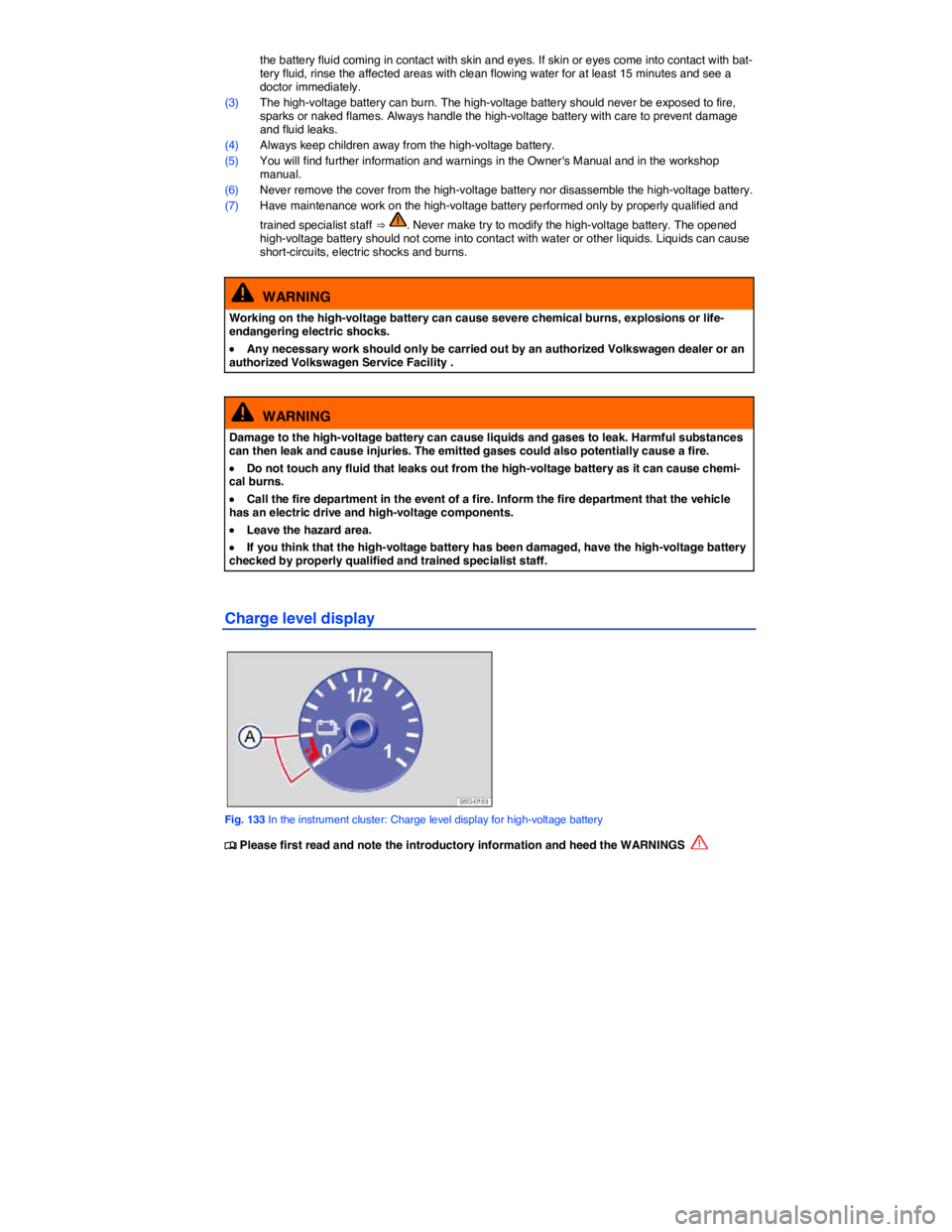2019 VOLKSWAGEN E-GOLF Car play
[x] Cancel search: Car playPage 53 of 394

A driver message appears in the instrument cluster display if there is no remote control vehicle key inside the vehicle or if the system does not recognize the remote control vehicle key. The key may not be recognized, for example, if it is covered by something that interferes with the signal (such as a briefcase), or if the remote control vehicle key battery is weak. Electronic devices such as mobile phones can also interfere with the signal.
Dirt on the door handles that contains a lot of salt (especially in winter) can affect the way the
door handle sensors work. Cleaning the door handles can help with this problem ⇒ page 334, Exterior care and cleaning.
If the automatic transmission is not in Park (P) position, the electronic steering column lock will not lock and the vehicle will not lock via sensors in the front door handles or the remote control vehicle key.
Anti-theft alarm system
�
Page 192 of 394

Infotainment system accessories
Vehicles equipped with an Infotainment system may have a CD player, SD card readers, or other
Infotainment System accessories ⇒ fig. 111 (2) in the glove compartment. See ⇒ Chapter Radio,
Navigation System for further information.
Owner's Manual
If the vehicle is not equipped with an Infotainment system, there is a slot for the Owner's Manual in the upper part of the glove compartment. Always keep the Owner's Manual in this slot or in the glove compartment as shown in (4).
Holders
Depending on vehicle equipment, there may be holders for SD cards (1), other types of cards (3), and a coin holder in the upper part of the glove compartment.
There may also be additional holders for coins, cards, or sunglasses in the glove compartment cover (5).
Cooling the glove compartment
There is an air vent (6) in the glove compartment. Cool air can be directed into the glove compartment if the air conditioner is on. Open or close the air vent by turning it.
WARNING
An open glove compartment door can increase the risk of serious injury during sudden brak-ing or driving maneuvers or in a crash.
�x Always keep the glove compartment closed while the vehicle is moving.
NOTICE
In some vehicle models, design considerations have made it necessary to have openings in the glove compartment behind the Owner's Manual slot, for example. Small items may fall through these openings and get behind the instrument panel. This can cause unusual noises and dam-age the vehicle. Never put any small objects in the glove compartment for this reason.
Storage compartment under the front seat
Fig. 112 Under the driver seat: Storage compartment.
Page 239 of 394

mance by applying more pressure to the brake pedal. But, during the break-in period, the stopping distance for hard braking and emergency braking will be longer until the brakes are fully broken in. Avoid hard braking and situations that might require hard braking (such as following other vehicles too closely) – especially during the break-in period.
Brake pad wear depends mostly on operating conditions and the way the vehicle is driven. If you do a lot of city and short-distance driving and/or have a sporty driving style, you should have the brake pads checked by an authorized Volkswagen dealer or authorized Volkswagen Service Facility more often than the regular service intervals.
Wet brakes (for example, after driving through water or washing the vehicle or after heavy rainfall) will not brake as well. Stopping distances will be longer when brake discs are wet or, in winter, even icy. Wet or icy brakes must be dried as soon as possible by carefully applying the brakes a couple of times while traveling at a relatively high speed. Make sure nobody is behind you and that you do not endan-
ger yourself or others ⇒ .
Brakes coated with road salt also react slower and need longer stopping distances. If there is salt on the roads and you are not braking regularly, brake carefully and gently from time to time to remove any
salt coating from the brake discs and pads ⇒ .
Brake disc corrosion (rust) and dirt buildup on the brake pads are more likely to occur if the vehicle is not driven much or is driven only for short distances with little braking. If the brakes have not been used and there is some rust on the discs, clean the brake discs and pads once in a while by carefully braking a couple of times while driving at relatively high speed to help clean the brake discs and pads.
Make sure nobody is behind you and that you do not endanger yourself or others ⇒ .
Brake system malfunction
If you brake and find that the vehicle doesn't brake nearly as well as it used to (sudden increase in stopping distance), a brake circuit may have failed. The brake warning light �H or �"�2�!�+�% will light up and a message may appear in the instrument cluster display. If you believe the vehicle is safe to drive, immediately take it to the nearest authorized Volkswagen dealer or authorized Volkswagen Service Facility for repair. Drive slowly and very carefully, allow for the longer stopping distance, and be ready to push longer and harder on the brake pedal to slow the vehicle down.
Electro-mechanical brake booster
The electro-mechanical brake booster works only when the electric motor is activated. It increases the force on the brakes above and beyond the pressure put on the brake pedal by the driver.
If the electro-mechanical brake booster is not working, you will have to push the brake pedal harder to
make up for the lack of booster assistance and the resulting longer stopping distance ⇒ .
WARNING
New brake pads do not provide maximum braking performance.
�x New brake pads do not have the best stopping power for the first 185 miles (300 km) and must be “broken in.” You can compensate for the slightly reduced braking force by putting more pressure on the brake pedal.
�x Drive with extra care while the new brake pads are being broken in. This reduces the risk of collisions and serious personal injuries due to a loss of control over the vehicle.
�x Never follow other vehicles too closely or put yourself into other situations that might require sudden, hard braking, especially when the brake pads have not been broken in.
Page 251 of 394

the battery fluid coming in contact with skin and eyes. If skin or eyes come into contact with bat-tery fluid, rinse the affected areas with clean flowing water for at least 15 minutes and see a doctor immediately.
(3) The high-voltage battery can burn. The high-voltage battery should never be exposed to fire, sparks or naked flames. Always handle the high-voltage battery with care to prevent damage and fluid leaks.
(4) Always keep children away from the high-voltage battery.
(5) You will find further information and warnings in the Owner's Manual and in the workshop manual.
(6) Never remove the cover from the high-voltage battery nor disassemble the high-voltage battery.
(7) Have maintenance work on the high-voltage battery performed only by properly qualified and
trained specialist staff ⇒ . Never make try to modify the high-voltage battery. The opened high-voltage battery should not come into contact with water or other liquids. Liquids can cause short-circuits, electric shocks and burns.
WARNING
Working on the high-voltage battery can cause severe chemical burns, explosions or life-endangering electric shocks.
�x Any necessary work should only be carried out by an authorized Volkswagen dealer or an authorized Volkswagen Service Facility .
WARNING
Damage to the high-voltage battery can cause liquids and gases to leak. Harmful substances can then leak and cause injuries. The emitted gases could also potentially cause a fire.
�x Do not touch any fluid that leaks out from the high-voltage battery as it can cause chemi-cal burns.
�x Call the fire department in the event of a fire. Inform the fire department that the vehicle has an electric drive and high-voltage components.
�x Leave the hazard area.
�x If you think that the high-voltage battery has been damaged, have the high-voltage battery checked by properly qualified and trained specialist staff.
Charge level display
Fig. 133 In the instrument cluster: Charge level display for high-voltage battery
�
Page 263 of 394

Control module display ⇒ fig. 136:
No. Display Meaning Proper re-
sponse
(4) Lights up
was detected by
the control unit.
The high-voltage
battery is not
being charged.
charging cable
from the 110 Volt
outlet and the
vehicle and plug
it back in.
- If necessary try
connecting the
cable to another
110 Volt outlet.
- Should the
error occur
again, have
charging cable
checked by a
qualified electri-
cal specialist. Go
to an authorized
Volkswagen
dealer or
Volkswagen
service facility for
assistance.
Enabling the charging process
After a successful self-test, press the button (1) to set the protection unit to ready and enable the charging process. The LED in the protection unit symbol (2) lights up green.
Ending the charging process
If you want to interrupt the high-voltage battery charging process before charging is completed, the charging process must be interrupted or ended on the vehicle
Checking the Ground Fault Circuit (GFI) of the 110 Volt outlet
The GFI should be checked once a month. Carry out this procedure with the charging cable connected to the 110 Volt outlet and the vehicle. The charging process has to be deactivated:
�x Press the test button (3) on the control unit of the charging cable for at about 3 seconds.
�x If the test was successful, the warning lights (1) and (2) will light up. Should these warning lights not light up or other lights should light up or flash, an error occurred while testing.
�x After a successful test and if error occurred, you can start the charging process by pressing the rest button (6) for at least 3 seconds.